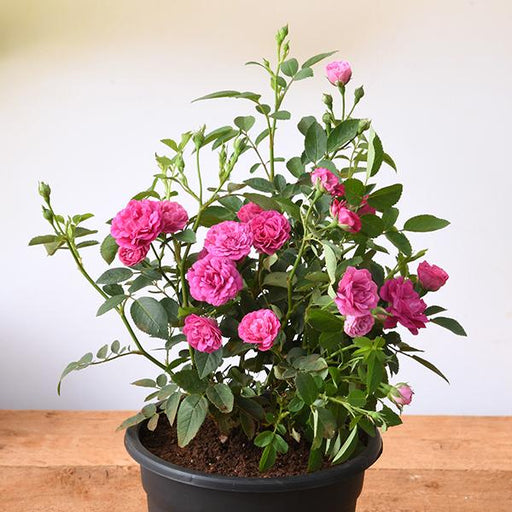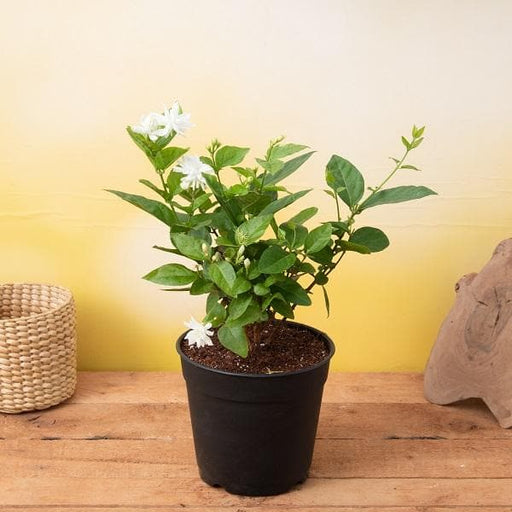
Butia capitata: Cocos capitata: Syagrus capitata - Plant
(MRP Inclusive of all taxes)
- Shipping ₹79 for entire order
- Dispatch in 7 days
- Country of origin: India

(MRP Inclusive of all taxes)
 Save 29%
Save 29%
Air Purifier Money Plant with Pot The Air Purifier Money Plant, also known as Pothos or Epipremnum aureum, is a stunning indoor plant that...
View full details
 Save up to 15%
Save up to 15%
Peace Lily, Spathiphyllum - Plant The Peace Lily, scientifically known as Spathiphyllum, is a stunning houseplant celebrated for its elegant white...
View full details
 Save 25%
Save 25%
Jasminum sambac, Mogra, Arabian Jasmine - Plant Jasminum sambac, commonly known as Mogra or Arabian Jasmine, is a fragrant flowering plant...
View full details
 Save 18%
Save 18%
Combo Constituents Includes the Parijat Tree (Night-Flowering Jasmine), a culturally significant plant with fragrant flowers. Description The Pari...
View full details
 Save 25%
Save 25%
Miniature Rose, Button Rose (Any Color) - Plant The Miniature Rose, also known as the Button Rose, is a charming and compact flowering plant that ...
View full details Save 25%
Save 25%
Damascus Rose, Scented Rose (Any Color) - Plant The Damascus Rose, also known as Rosa damascena, is a timeless symbol of beauty and romanc...
View full details
 Save 17%
Save 17%
Beautiful Fragrant Mogra, Arabian Jasmine Plant with Pot The Beautiful Fragrant Mogra, also known as Arabian Jasmine (Jasminum sambac), is...
View full details Save 15%
Save 15%
Pack of Vermicompost and Neem Cake for House Plants Transform your indoor garden with our premium Pack of Vermicompost and Neem Cake, spec...
View full details
Pack of Plant Growth and Flower Boosters Unlock the full potential of your garden with our Pack of Plant Growth and Flower Boosters! This ...
View full details Save 38%
Save 38%
Combo of Jeevamrut and Neem Raksha for Easy Growth and Protection of Houseplants Transform your indoor garden with our exclusive combo of ...
View full details Save 22%
Save 22%
Plant Nutrients Kit (Pack of 16) for a Healthy Garden Transform your garden into a lush paradise with our Plant Nutrients Kit, featuring 1...
View full details Save 16%
Save 16%
Combo of Top Plant Fertilizers Elevate your gardening game with our exclusive Combo of Top Plant Fertilizers, featuring two bags of premiu...
View full details Save 24%
Save 24%
Pack of 4 Additives to Make Soil Healthy and Nutrient Rich Transform your garden into a thriving ecosystem with our Pack of 4 Additives de...
View full details Save 30%
Save 30%
Transform your gardening experience with our premium Combo of Perlite and Vermiculite. This unique blend is designed to enhance soil aeration and ...
View full details Save 27%
Save 27%
Combo of 2 Vermicompost and Cocopeat - Enrich Your Soil Naturally! Transform your garden into a thriving ecosystem with our Combo of 2 Ver...
View full details
 Save 35%
Save 35%
Best 6 Plants for Perfect Indoor Garden Transform your living space into a lush oasis with our curated collection of the Best 6 Plants for a...
View full details
 Save up to 50%
Save up to 50%
Mini Succulent Garden Pack Transform your space with our Mini Succulent Garden Pack, featuring a delightful collection of 4 any variety beautiful s...
View full details
 Save 30%
Save 30%
5 Best Fragrant Plants Transform your garden or indoor space into a fragrant paradise with our curated selection of the 5 Best Fragrant Plants. Th...
View full details
 Save 24%
Save 24%
Set of 2 Bonsai Looking Grafted Adeniums Transform your indoor or outdoor space with our exquisite Set of 2 Bonsai Looking Grafted Adenium...
View full details Save 45%
Save 45%
Top 4 Die Hard Succulents Pack Transform your indoor or outdoor space with our Top 4 Die Hard Succulents Pack, featuring a curated selecti...
View full details
 Save 30%
Save 30%
5 Best Indoor Plants Pack Transform your living space into a lush oasis with our '5 Best Indoor Plants Pack.' This carefully curated collection fe...
View full details
 Save 25%
Save 25%
Set of 4 Evergreen Air Purifier Plant Pack Transform your indoor space into a lush, green oasis with our Set of 4 Evergreen Air Purifier Pla...
View full details| SrNo | Item Name |
|---|---|
| 1 | Butia capitata: Cocos capitata: Syagrus capitata - Plant |
Butia capitata, commonly known as the Pindo Palm, is a stunning tropical plant native to South America, particularly Brazil and Argentina. This hardy palm is celebrated for its graceful arching fronds and attractive golden fruits, which are not only visually appealing but also edible. The Pindo Palm thrives in a variety of soil types and is drought-tolerant, making it an excellent choice for gardens and landscapes in warmer climates.
What makes Butia capitata special is its unique ability to adapt to different environments, from coastal areas to inland gardens. Its resilience and low maintenance requirements make it a favorite among gardeners and landscapers alike. Additionally, the Pindo Palm's fruit is often used to make delicious jellies and wines, adding culinary value to its ornamental beauty.
This palm's special feature is its striking blue-green fronds that can grow up to 10 feet long, creating a dramatic focal point in any garden. The fruit, resembling small dates, is not only edible but also attracts wildlife, enhancing biodiversity in your garden.
Butia capitata plays a significant role in its ecosystem by providing food and habitat for various bird species and insects. Its drought tolerance helps in conserving water, making it an eco-friendly choice for sustainable landscaping.
Also known as the Pindo Palm, this tropical beauty is like the life of the party in your garden. With its feathery fronds and a penchant for producing sweet, edible fruits, it’s the palm that brings the beach vibes to your backyard. Just imagine sipping a piña colada while lounging under its shade—pure bliss!
This name might sound fancy, but it’s just another way to say “delicious coconut palm.” Cocos capitata is the life of the tropical ecosystem, providing not just shade but also a bounty of coconuts. Who wouldn’t want a tree that doubles as a snack bar?
The scientific name that sounds like a spell from Harry Potter, Syagrus capitata is a palm that casts a charm on any landscape. With its tall stature and graceful leaves, it’s the perfect tree for those who want to impress their neighbors without breaking a sweat.
Caring for your Butia capitata is easier than finding a good avocado toast recipe. Just give it some sunlight, occasional watering, and a sprinkle of love, and it’ll thrive like a diva in a spa.
The fruit of the Butia capitata is like nature’s candy—sweet, tangy, and perfect for snacking. It’s the kind of fruit that makes you feel like a tropical explorer, even if you’re just in your backyard.
If you’re dreaming of a tropical paradise, Butia capitata is your go-to plant. It’s the palm that says, “Why not turn your yard into a vacation destination?” Just add a hammock, and you’re set!
Butia capitata is the tough cookie of the palm world. It can withstand colder temperatures than most of its tropical cousins, making it the perfect choice for those who want a taste of the tropics without moving to Florida.
This palm is like the friend who never asks for anything—low maintenance and drought-tolerant. It’s perfect for those who want a lush garden without the constant watering hassle.
With its stunning silhouette and graceful fronds, Butia capitata adds a touch of elegance to any garden. It’s the kind of tree that makes your garden look like it belongs in a magazine.
Butia capitata is just one of many palm tree varieties, but it’s the one that stands out like a peacock at a pigeon convention. Its unique characteristics make it a must-have for any palm enthusiast.
Planting Butia capitata is a step towards sustainable gardening. It’s not just a pretty face; it contributes to biodiversity and provides food for local wildlife. Who knew being eco-friendly could look so good?
If you’re looking to add some pizzazz to your fruit garden, Butia capitata is the way to go. It’s not just a tree; it’s a conversation starter, a snack provider, and a tropical dream all rolled into one.
Butia capitata, also known as Cocos capitata or Syagrus capitata, is a charming palm native to South America. With its feathery fronds and sweet, edible fruits, it’s like the tropical party guest that brings snacks and good vibes. Perfect for gardens that need a splash of flair!
Caring for Butia capitata is a breeze! Just give it well-draining soil, plenty of sunlight, and occasional watering. Think of it as a low-maintenance friend who only asks for a little love and attention. Avoid overwatering, or it might throw a tantrum!
Butia capitata isn’t just a pretty face! Its fruits are not only delicious but also packed with nutrients. Plus, it adds a tropical aesthetic to your garden, making it the envy of all your neighbors. Who wouldn’t want a palm that’s both tasty and stylish
While Butia capitata dreams of sunny outdoor adventures, it can survive indoors if given enough light. Just make sure it has a spacious spot by a window, and it might just forgive you for keeping it inside. But remember, it’s a palm, not a houseplant diva!
Butia capitata thrives in warm, tropical climates, but it can handle a bit of chill. Think of it as the palm that loves a good vacation! Ideally, temperatures should stay above freezing, so if you live in a colder area, consider giving it a cozy winter blanket.
Butia capitata can reach heights of 10 to 20 feet, depending on its mood and environment. It’s like that friend who can’t decide whether to stand tall or lounge low. Just give it space, and it’ll stretch its legs—err, fronds—happily!
Yes, Butia capitata is quite the water-saver! Once established, it can tolerate drought conditions, making it the eco-friendly palm of your dreams. Just don’t forget to water it during its early days; even the toughest palms need a little pampering to grow strong!
Butia capitata is generally pest-resistant, but it can occasionally attract pesky critters like scale and spider mites. Think of them as uninvited guests at a party. Regular checks and a good spray of insecticidal soap can send them packing!
Absolutely! The fruit of Butia capitata is not only edible but also deliciously sweet. It’s like nature’s candy, perfect for snacking or making jams. Just be prepared to share, as your friends will definitely want a taste of this tropical delight!
Butia capitata has a moderate growth rate, typically adding about 1 to 2 feet per year. It’s not a speedster, but it’s not a sloth either! With the right care, you’ll see it flourish and grow into a stunning palm in no time.
You can find Butia capitata at local nurseries, garden centers, or online plant retailers. Just make sure to choose a reputable seller, or you might end up with a palm that’s more “meh” than magnificent. Happy hunting for your new green friend!